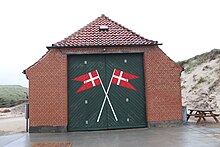Løkken Redningshus
The first Løkken Redningshus ( German rescue house ) in Løkken was built in 1852. The Danish rescue service ( Danish Redningsvæsen ) was officially founded in 1851. Løkken, along with Skagen , Kandestederne and Sønder Lyngvig, was one of the first places to receive a rescue station.
history
Between 1858 and 1892 1722 ships ran aground along the west coast of Jutland , on average one ship per week. Because of the storms, the lack of knowledge of the area and the fog, it was dangerous to pass the coast of Skagen and Vendsyssel . Even before the rescue service was founded, fishermen were often involved in rescuing the shipwrecked.
The first rescue station was located on Sdr. Strandvej and was used to accommodate a lifeboat . The boat was a simple row boat . Over the years his crew, which consisted mainly of local fishermen, managed to save several people from drowning in the North Sea . On June 9, 1929, the old station's lifeboat sank. The boat was on its way to a distressed fishing boat during a storm. Three of the twelve rescuers were killed.
After the accident, it was decided to purchase a motor lifeboat that was in a shed in the dunes until 1936 so that the boat could be brought into the water quickly if necessary. The rescue station in the dune at Ndr. Strandvej was built in 1936. The rowing boat, which was still used occasionally, stayed in its old place on Sdr. Strandvej.
The red brick house with the emblem of the rescue service at the gate was home to the motor lifeboat MRB18, which was then relocated to Thorup . That year the Løkken rescue station was closed.
The Danish authority Farvandsdirektoratet then started negotiations with the Løkken-Vrå municipality about a possible relocation of the station. At the time the house was in very bad shape. The negotiations ended with the municipality being able to take over the building free of charge in 1978, provided that they would carry out the renovation themselves.
Another condition was that the building should only be used for public purposes. The old rescue station was equipped with public toilets and an ice cream parlor. The gates could be decorated with the Dannebrogs flag, although it was no longer an official building.
The Løkken Museumsforening got to use part of the building as showrooms permission. The Løkken Sportsdykkerklub (scuba diving club) got a room for its equipment.
In 1988 the ice cream kiosk was moved to the beach and the diving club also occupied the ground floor. The museum association wanted to put an old lifeboat in the house, possibly the motor lifeboat MRB18 after its decommissioning. The plans with the motorboat were never realized.
In 1992 the entire rescue station was transferred to the museum. The museum had previously acquired the Bent II inshore fishing boat , which became the main attraction of the museum's new inshore fishing exhibit.
For years there have been problems with the sand that had been removed, which in 1978 almost destroyed the house. These problems continued over the next few decades. The sea ate more and more of the coast. During the Egon storm on January 10, 2015, the old rescue station was damaged.
Extensive security measures were taken in 2016.
Web links
- Redningshuset i Løkken. vendsysselwiki.dk. Retrieved October 14, 2019 (Danish).
- Kystfiskerimuseet. In: loekkenmuseum.dk. Retrieved October 14, 2019 (Danish).
Individual evidence
- ↑ Redningsvæsen. Retrieved October 1, 2019 (Danish).
Coordinates: 57 ° 22 ′ 24.3 " N , 9 ° 42 ′ 34.6" E



